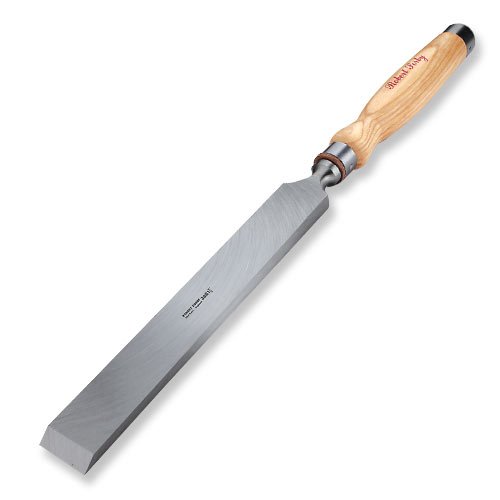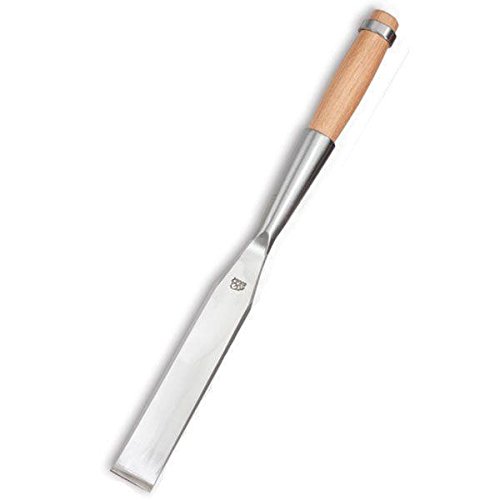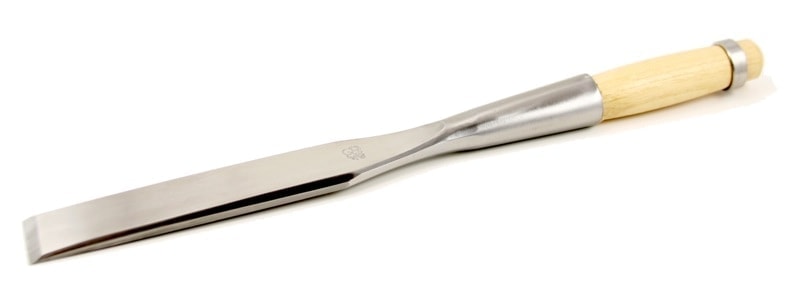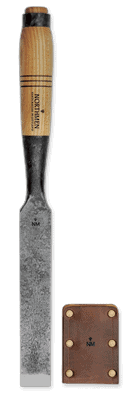Timber framing and shipbuilding are crafts that enjoy centuries of rich history, and one common thread has been good chisels. The precision work accomplished by the craftsmen in these trades passes the test of time. It seems only fitting that today’s woodworking artisans should have tools that reflect their traditions. A quality timber framing chisel is pivotal to making your project a success and makes a wonderful addition to your tool arsenal. Here we compare three of the best.
Barr 1-1/2" Framing Chisel

Barr tools occupy a very special place for this craftsman. It’s rare that common hand tools like chisels are hand-forged and tempered. Most chisels today are mass produced, but Barr Quarton applies two decades of experience working with tool steel and hammer forges these densely-packed metal gems. This framing chisel enjoys the Barr fitted, ash socket handle, steel ferrules and long-lasting edge. The blade runs 7 inches with an overall tool length of 18 inches. Keep in mind these tools are individually forged so size may vary slightly.
Having this 1 ½-inch chisel for its quality, strength. It’s a workhorse, but proper tool sharpening knowledge and skill are vital to make sure they work a smooth as possible. Made in Idaho, these hand-crafted beauties are meant to be passed down from generation to generation, my son is already eying mine.
This Robert Sorby Chisel features an ash handle, steel ferrule cap and hoop. The design incorporates a leather cushion washer at the bolster and this 20-inch hand tool is a favorite among timber framers and shipwrights. Made in Sheffield, England, the maker touts itself as a tool line “designed by craftsmen for craftsmen” and the chisels are forged from home-grown, Sheffield precision ground steel. The long tang enjoys a deep seating into the handle for tremendous strength. This framing chisel sports a 10 ½-inch blade for handling deep mortices and joinery work.
Robert Sorby chisels get high praise for durability and the toughness of their special alloy. The traditional bevel demonstrates excellent sharpness and handles wonderfully. This is a classic chisel that could satisfy any craftsman. They only downside of this chisel is that will tear up a wooden mallet quickly due to the steel ferrule cap.
John Neeman Timber Framing Chisel 1.5”
Like Barr, John Neeman Tools trusts in the age-old ways of blacksmithing. Neeman recently became a guild of northern European craftsman, called Northmen, and takes pride in the Medieval tradition of tool-making. This particular timber framing chisel is hand-forged with high carbon spring steel. The edge reaches a Rockwell hardness of 58-60. Each hand-crafted chisel is treated with a traditional mix of beeswax, linseed oil and pine turpentine to create an anti-rust finish. The hand-lathed elm handle is individually made to precisely fit its unique socket. With an 8.4-inch blade, the chisel spans a total of 18.3 inches and comes with a custom leather guard.
Neeman chisels have the look and feel of something Viking shipwrights used. They may last just as many generations going forward. Without question, a Neeman chisel is one of the finest tools available to contemporary woodworkers. And, it affords today’s framers and shipwrights a kind of Renaissance by bringing together a tool made the ancient way to a craft forged long ago.
Please note:
Timber Frame HQ is a participant in the Amazon Services LLC Associates Program, an affiliate advertising program designed to provide a means for us to earn advertising fees by advertising and linking to amazon.com. When you purchase something from Amazon, a small percentage of the sale goes to support the efforts of TFHQ.




Interesting, no Japanese chisels in there…. I have the first 2, 2″ Barr and 1.5″ Sorby, like them both.
As for Neeman tools, I’ve had 2 axes made by them and the first one was the worst axe I ever had, and the replacement one took 2 years to make it in my hands and it was marginally better… They don’t have the experience and the skills for the price they are asking in my book!
Anyway, I’m happy with the Barr and Sorby, that said the Sorby took a bit of work to get going, but in the end it is a good chisel!!
I am trying to get my hands on Japanese chisels to try them out to add to the article. Thanks for your thoughts on the rest.
I have two Japanese chisels – a 1 1/2″ and a 2″. Maybe I can get them to you sometime so you can add them to your evaluation.
Which type do you have, planning on buy one to try and and add to the review. Any recommendations?
Can you recommend sharpening stones? i just bought the Stanley Sweet Heart Chisels but don’t know how to start using them. Thank.s
I have and thoroughly enjoy my set of Japanese Waterstones. In my minimal collection, I have a green stone(rough for getting out dings) and a 400 and 1000 combination stone. That is all I have ever needed and recommend.
I tried all methods of sharpening, and had finally settle on Japanese water-stones. That was until I bought a large diamond stone to keep them flat. Since then I have purchased the full range of quality diamond stones, and has never used my water-stones again.
The advantage of quality diamond stones over water-stones are:
– Always flat
– no soaking or maintenance (just wipe them clean after use)
– I don’t have to protect them from frost (I live up north)
– remove material quickly
– they come in large size ideal for slicks, framing chisels, and plane irons
Their only down-side is cost (but quality water-stones are not cheap either!)
My extra-extra-fine diamond stone will put a mirror finish on my edges, and after a quick stropping, the finish is equivalent to the one I get from a 8000 water-stone.
I have just never made the commitment yet, although I am getting close to replacing one. Think after reading your thoughts I am swayed into getting a diamond stone. Thanks!
Well…without breaking the bank, a simple less expensive method that I have been using since I purchased my chisels has been wet sandpaper from the local car and body shop. You can find a great number of grit sandpaper from course right up to 2500 grit.
I cut the appropriate size piece I require and use an adhesive to secure it to my flat surface (piece of flat stone tile). I give it a spritz of water and use my chisel guide to keep it at the required angle. Just a few passes on each different grit and they come out razor sharp. No need to spend oodles of money on wet stones or diamond stones. However, everybody is different and has their own preference. Just my two cents worth.
Great suggestion Chris. I have heard about that method before with great success.
The Japan Woodworker was bought by Woodcraft their background may help. Also Hida Tool with a great supply of many TF edged tools. Hida supplies many choices for chisels, slicks, saws, etc. in longer blade lengths required for TF. I’ve been using many types and good Japanese edged tools are the best although there is a learning curve in maintenance and applications. As for stones I prefer black diamond, 1000 grit with 8000 grit thereafter gold water stones it’s a very efficient system once learned.
Thanks for the info and your thoughts James, I too have long been a fan of Hida Tools.
One of these days Ivey’s Forge will be on this list of top hand forged tools. Plus in my book hand forged means not using power tools like most smiths these days use. Still Sorby and Barr are great tools and I have used both but I have never heard of Neeman and from what I have read they don’t seem to be too good. I have just recently got into timber framing so I am still in process of finally making all of my own tools for myself and to sale.
I would love to see your one of your chisels. Send some pictures when you can.
Where can I buy diamond sharpening stones for my Barr chisels, recommend a brand and grit?
I recommend the DMT diamond stones. You can find them on Amazon, highlandhardware.com and through a Google search. I would get a course and a fine one.
stumbled across 3 norvell shapliegh hardware co chisels either with no wood handles or ones that look like someone beat with a blacksmith hammer. Anybody know ehere to find replacements or do I have to find someone with a wood lathe (naturally I got rid of the little one Dad had. Thanks Bob Jr.